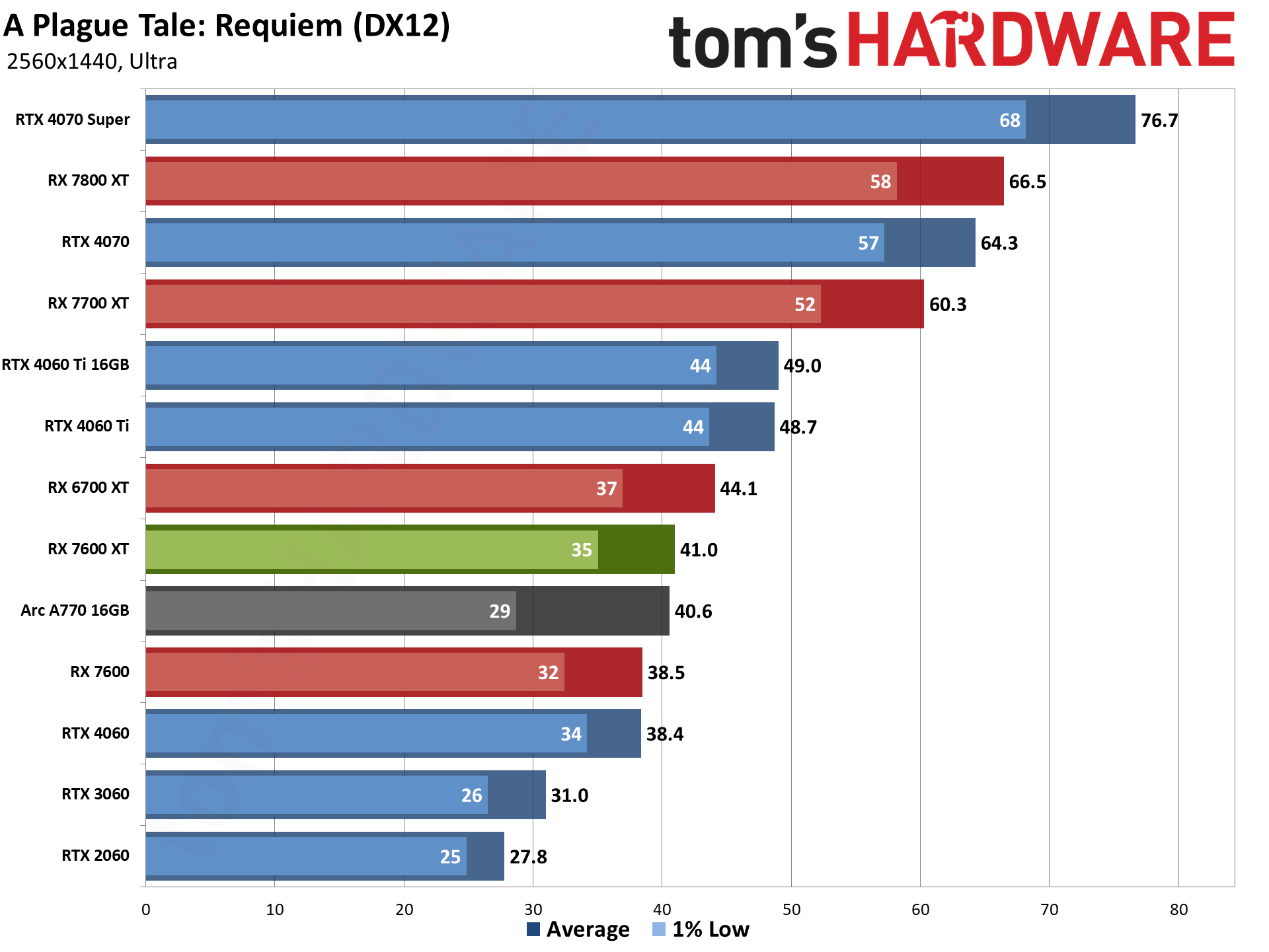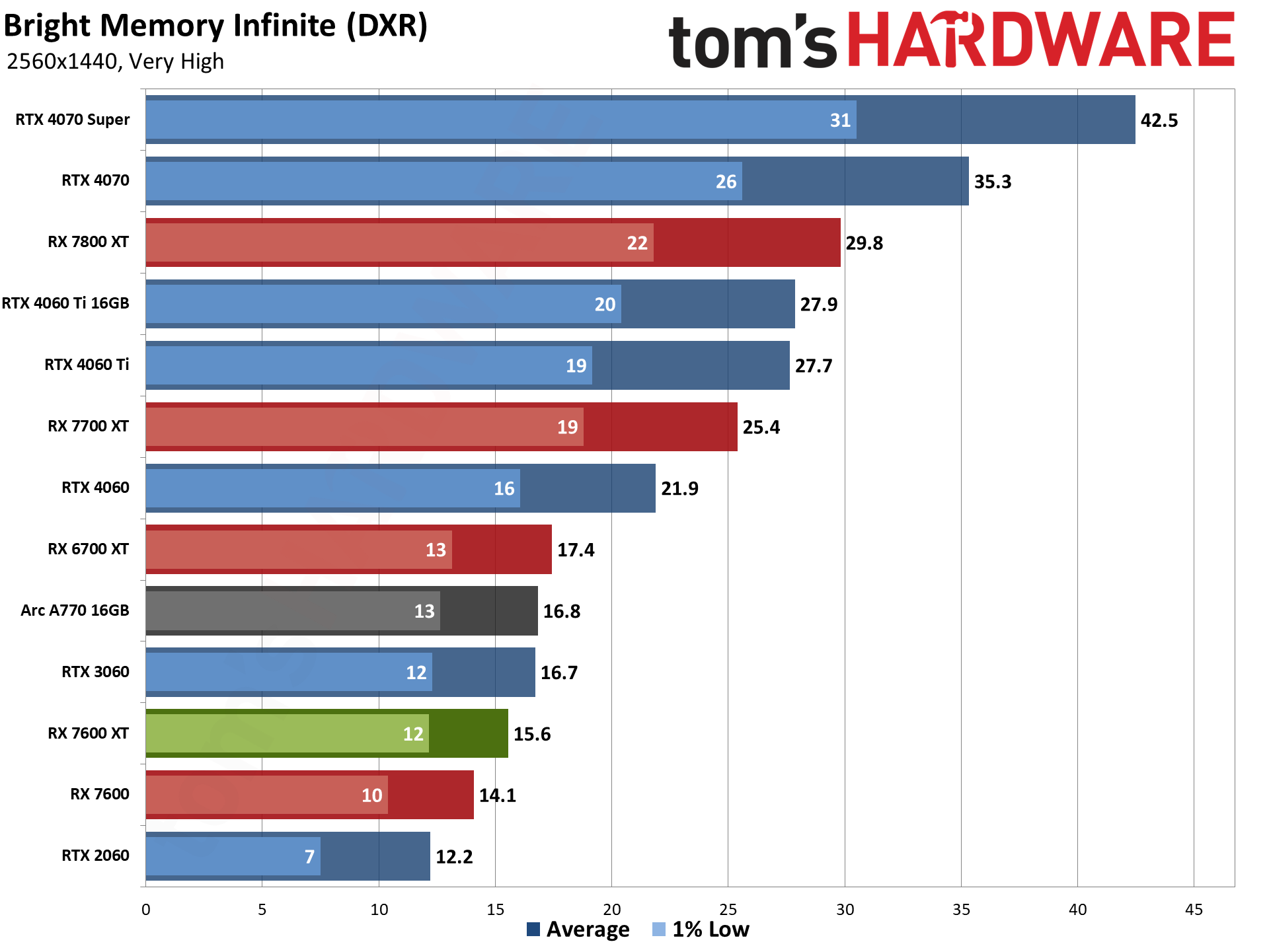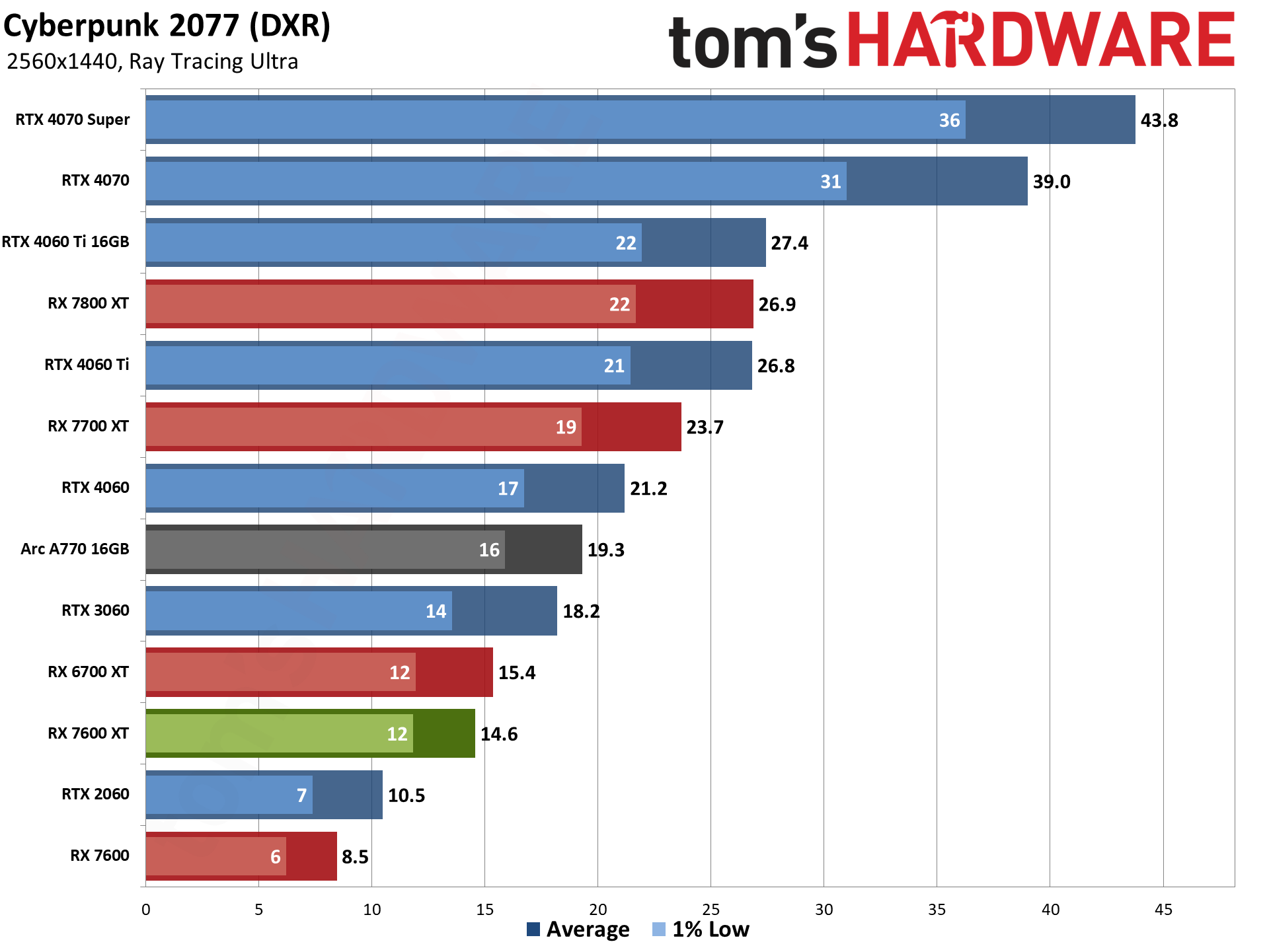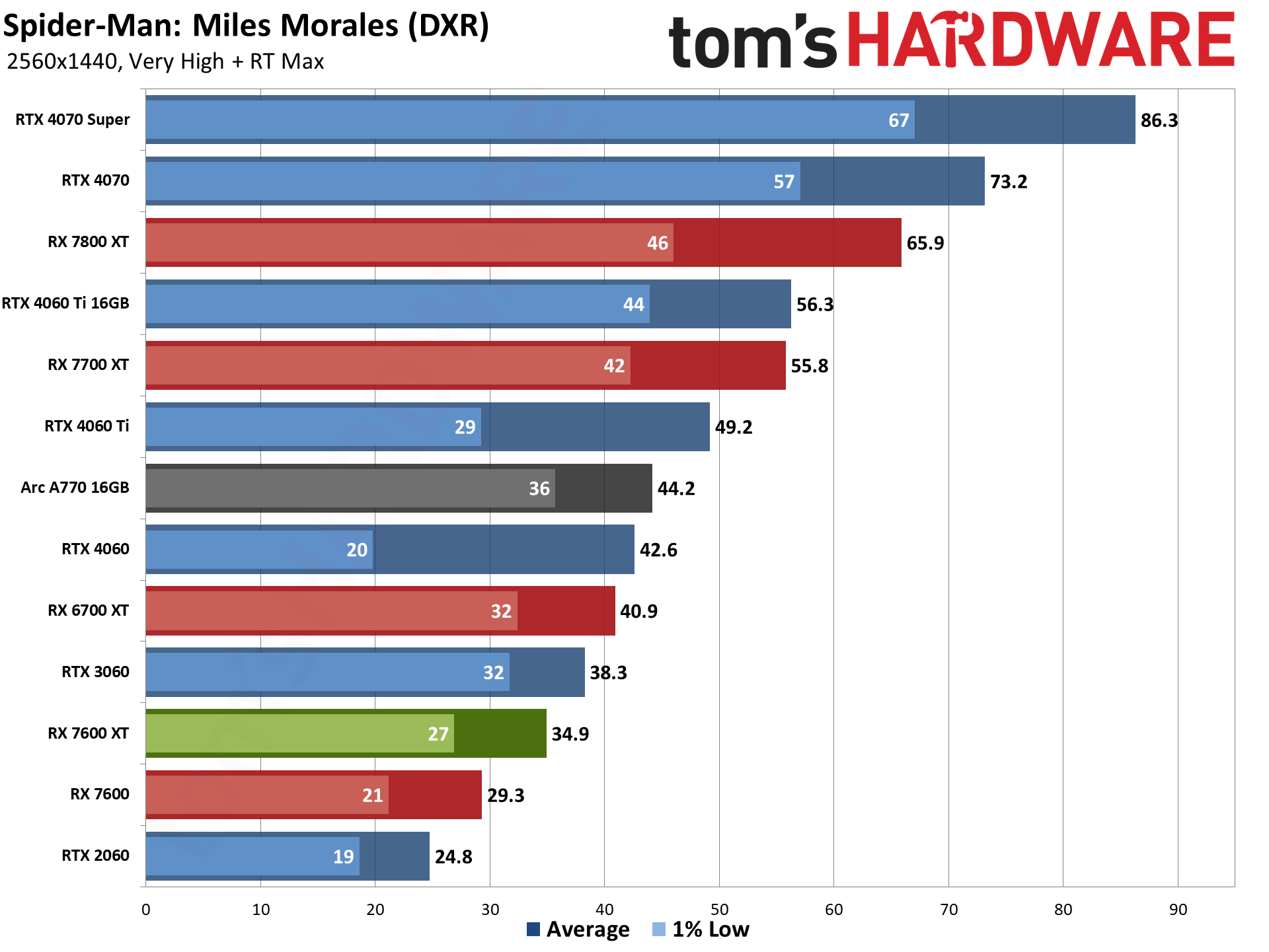Why you can trust Tom's Hardware
1080p ultra was mostly fine on the RX 7600 XT, but 1440p is about as far as you'll want to push things. Of course, you can always give AMD Fluid Motion Frames (AFMF) a shot — it's driver-level frame generation that works with most games. Sort of.
We didn't have time to fully test it for this review, and we still have some general concerns with all forms of frame generation. Basically, it's more like frame smoothing and the resulting "performance" feels very much like marketing propaganda rather than being truly beneficial. Also, in the games I've tried on the RX 7600 XT (Control, Cyberpunk 2077), it wasn't a great experience. AFMF created more stuttering and inconsistency of performance, and the games were better with it turned off — even if the AMD overlay was showing significantly higher fps values.
Anyway, let's take a look at the 1440p results and save a deeper dive into AFMF for a future day when we have more time to do rigorous testing. With four different GPUs launching in three weeks, we're simply going to have to pass on that aspect of testing for now.
AMD RX 7600 XT 1440p Overall Performance

Our overall 1440p performance chart says basically the same thing as the 1080p ultra overall chart. It's clearly faster than the vanilla 7600, by 15% this time. It's also clearly slower than the RX 6700 XT, and the RTX 4060 as well — again, the latter is mostly due to our inclusion of ray tracing tests.
With a 42 fps composite score, obviously that means many of the games in our test suite are no longer breaking 60 fps. To be precise, five of the games still broke 60 fps (all rasterization games), but five other games also couldn't even break 30 fps (all ray tracing games). Upscaling and AFMF could help, naturally, but that applies to faster GPUs as well.
If you have a 1440p display and you're looking at the RX 7600 XT, lighter games should have no issues. But then that's also true of the RX 7600, because lighter games don't need the extra VRAM. Our test suite is definitely more demanding, but it's also a more realistic look at things besides popular esports titles that can run fine on just about anything.
AMD RX 7600 XT 1440p Rasterization Performance










Considering the majority of games released every year are rasterization only, these charts are arguably more meaningful than the DXR charts below. But if you're mostly playing major releases rather than the thousands of indie and shovelware titles that show up on Steam each year, keep in mind that ray tracing support is becoming pretty common from the major engines and games.
Average performance at 1440p on the RX 7600 XT is just over 60 fps, and none of the games we tested fell below the 30 fps mark. The uplift over the RX 7600 is 11%, it's 5% faster than the 4060, 25% faster than the previous generation 3060... and 8% slower than the RX 6700 XT. It's also 16% slower than the more expensive 4060 Ti.
AMD RX 7600 XT 1440p Ray Tracing Performance







There's really not much to add here. AMD still hasn't really put forwards a high performance ray tracing architecture. The top RDNA 3 GPUs like the 7900 XTX can certainly handle DXR games at 1440p, but even they fall behind less expensive Nvidia cards. If you want to dabble with ray tracing in games, or even if you think you might only want to give it a shot, you should look to Nvidia's GPUs or wait and see what the next generation RDNA 4 GPUs have to offer.
AMD RX 7600 XT 1440p Bonus Games



Considering our bonus games are more demanding titles — much more demanding in the case of Alan Wake 2 — at least one of the above charts is more for laughs than anything serious. 7 fps with full path tracing? Pass, thanks.
Avatar remains very playable, and we found in our testing that the FSR 3 frame generation actually felt better than in other games. That means you can even get 60 fps with the 7600 XT if you turn it on. And you can also get 60 fps with an RTX 4060 with FSR 3 frame generation.
Performance in The Last of Us, Part 1 also lands at 43 fps on the RX 7600 XT. That's without upscaling, and the game does support FSR 2, so you can improve things even more if you turn that on. And then AFMF could give you an additional smoothness boost for higher refresh rate displays.
- MORE: Best Graphics Cards
- MORE: GPU Benchmarks and Hierarchy
- MORE: All Graphics Content
Get Tom's Hardware's best news and in-depth reviews, straight to your inbox.
Current page: AMD RX 7600 XT: 1440p Gaming Performance
Prev Page AMD RX 7600 XT: 1080p Gaming Performance Next Page AMD RX 7600 XT: 4K Gaming Performance
Jarred Walton is a senior editor at Tom's Hardware focusing on everything GPU. He has been working as a tech journalist since 2004, writing for AnandTech, Maximum PC, and PC Gamer. From the first S3 Virge '3D decelerators' to today's GPUs, Jarred keeps up with all the latest graphics trends and is the one to ask about game performance.
-
Roland Of Gilead AMD's version of the 4060ti! :rolleyes: Disappointing it comes behind even the Arc770.Reply -
btmedic04 This would have been a much more compelling product had it used a further cut down Navi 32 with 3x mcds, 12gb of vram and a $350ish price point. DisappointingReply -
King_V Reply
Well, AMD's version of the 4060ti 16GB, I would say... although, to be fair, it does give SOME performance benefit over the 7600 non-XT. The 4060 Ti 16GB gave just about nothing over the 4060 Ti 8GB (for gaming purposes, an edge case or two notwithstanding)Roland Of Gilead said:AMD's version of the 4060ti! :rolleyes: Disappointing it comes behind even the Arc770. -
JarredWaltonGPU Reply
I do wonder if AMD may eventually try doing an RX 7700 non-XT with those specs, but realistically I think the total cost of 3xMCD plus the Navi 32 GCD means making such a card and selling it at $350 is a losing proposition.btmedic04 said:This would have been a much more compelling product had it used a further cut down Navi 32 with 3x mcds, 12gb of vram and a $350ish price point. Disappointing -
btmedic04 Reply
Yeah, it's more than likely too expensive to hit a $350 price point and still have any kind of profit margin. One can still dream at least lol.JarredWaltonGPU said:I do wonder if AMD may eventually try doing an RX 7700 non-XT with those specs, but realistically I think the total cost of 3xMCD plus the Navi 32 GCD means making such a card and selling it at $350 is a losing proposition. -
Roland Of Gilead Reply
TrueKing_V said:Well, AMD's version of the 4060ti 16GB, I would say... although, to be fair, it does give SOME performance benefit over the 7600 non-XT. The 4060 Ti 16GB gave just about nothing over the 4060 Ti 8GB (for gaming purposes, an edge case or two notwithstanding) -
usertests +$60 is not a huge premium over the 7600 for the extra memory, but the 7600 is overpriced in the first place.Reply
It's not much slower than the 6700 XT, but the 6700 XT is clearly better and 12 GB VRAM is fine. If you want the 7600 XT to play with AI, good luck.
Get it down to $270-280, what the 6700 10 GB used to cost, and it looks more interesting. Although 6700 XT was as low as $295-300 (new) in Nov-Dec. Something tells me they will run out before they return to that price point.
